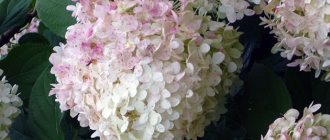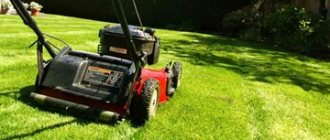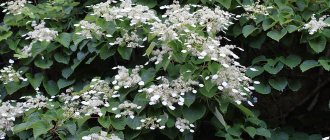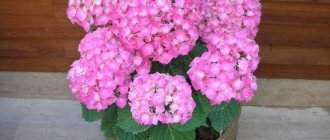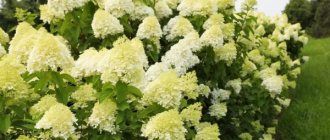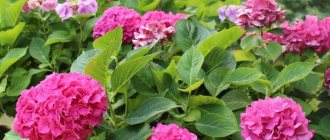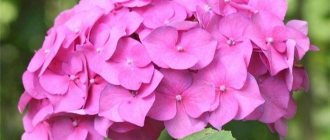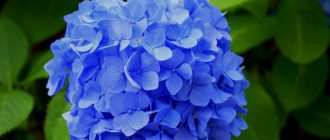Description
There are about 80 varieties of hydrangeas in the world. Small-sized hydrangeas are grown indoors: garden or large-leaved.
Hydrangea is divided into two types: bushy or tree-like, capable of growing 3 meters in height, and in the form of a vine, climbing up a tree trunk up to 30 meters or as long as its height allows. Types of hydrangea: deciduous and evergreen. In the temperate zone of Russia, a predominantly deciduous species grows.
The flowers of the plant come in different colors: white, pink, cream, purple, blue, indigo and red. The inflorescences are spherical or umbrella shaped. The fruit with seeds of hydrangea is in the form of a box with 3-5 sections.
Interesting. The color of a hydrangea flower depends on the acidity of the soil. In a neutral soil mixture, cream or beige flowers bloom, in a more alkaline mixture, pink and lilac flowers bloom, in acidic soil, with a predominance of aluminum, blue hydrangeas grow.
Hydrangea is very resistant to diseases and pests.
Hydrangea flowers in the garden
Reasons for the slow growth of hydrangea.
There are a number of reasons why hydrangea growth may slow down, the number of inflorescences may decrease, or flowering may not occur at all. 1. Improper preparation of the plant for winter. If you did not protect the hydrangea from heavy autumn rains, then the root system could begin to rot in the winter. The shoots could freeze if the shelter was not of sufficient quality. The root system of hydrangea is shallow, so there is a risk of damaging it in the process of loosening the soil; this must be done very carefully. Well, if you transplanted the hydrangea too late in the fall, then perhaps it did not have time to take root and froze in the winter.
Growth after planting
Why does paniculata hydrangea not bloom?
Hydrangea is planted in early spring or autumn in fertile and loose soil. It is better to choose a place for planting that is protected from the winds and with slight shading, without direct sunlight. Under the sun, the plant grows poorly, the flowers become small and faded.
Hydrangea is propagated in three ways: cuttings, dividing the bush and layering.
Growing seedlings into a healthy and beautifully flowering plant is possible if certain planting conditions are :
- A pre-prepared mixture of peat, turf and sand is poured into a hole 30x30x30 cm. Next, mineral fertilizer is poured. The root is not completely covered; the neck remains on the surface.
- After planting, regular and moderate watering is required.
When dividing
The bush must be separated with strong roots so that the plant can take root in a new place.
Time: autumn or spring.
When cutting
Cuttings, in the form of young shoots, are cut from the plant. The leaves are removed from the bottom, the cut site is treated with a solution to accelerate growth and planted in nutritious soil. With the petiole method, the cuttings are covered with a jar to create a greenhouse effect. After engraftment, the cuttings are transplanted to a permanent place.
Time: February. In late autumn, the parent bush is transplanted into a pot and placed indoors, up to +2 degrees Celsius, gradually increasing the temperature to +10 degrees by February.
Hydrangea cuttings
During layering
Young shoots, without being separated from the mother bush, are buried in the ground. The length of the shoot is about 20 cm. After six months or a little earlier, the young shoot is separated from the bush and replanted. Time: late autumn.
Why don't hydrangeas bloom in open ground?
This flower has many varieties. For example, large-leaved garden hydrangea can grow on a plot for many years, pleasing the eye with the shape of the bush and the color of the leaves, but not bloom. Young tree-like and paniculate hydrangeas also do not bloom, because they do not have enough strength to do so or they are provided with unsuitable conditions for growth. But this happens rarely, do not be alarmed. Why doesn't hydrangea bloom in the garden? There are many reasons, let’s consider some of them using the example of large-leaved hydrangea:
- A recently planted hydrangea may not bloom because its root system is not yet sufficiently developed. Over time, when the plant gets stronger, everything will work out. This also happens when a flowering shrub is planted in the ground. In this case, you will have to admire the beauty of the bush’s shape and leaves for a couple of years.
- Many gardeners regularly cut off the top part of last year's shoots, considering this to be correct. Alas, you should know that this is where hydrangea flowers appear.
- If flower buds are damaged during spring frosts, it is likely that the plant will not bloom that year.
- The question often arises about why hydrangeas do not bloom outside. Yes, you just chose a species that is not suitable for your climate, that’s all. There may be no other reasons. It is known that the northern regions have short summers, and flower buds simply do not have time to ripen.
Care in autumn and winter
Why doesn't hydrangea bloom for a long time?
In autumn, watering hydrangeas should be reduced and vitamin and mineral phosphorus-potassium fertilizers added. The roots are mulched with sawdust, dry leaves, pine needles, and crushed pine bark. In winter, the roots can be additionally sprinkled with snow.
When hydrangea does not grow well after winter, the reason lies in its pruning in the fall. It is necessary to prune so that the branches are not damaged in winter: cut off the lower and middle leaves, which can be infected and damaged by fungal spores, and shoots, leaving only up to five healthy and strong ones.
Hydrangea propagation. shoot
During the winter months, hydrangeas should be covered as soon as the first frost occurs. This especially applies to small bushes of the plant. Rain film can be used as a covering material. During severe frosts, wooden boxes are used, lined with heat-insulating material on the inside.
For your information. You especially need to watch the upper branches. At night, the temperature often drops and the branches may freeze.
Hydrangea varieties such as paniculata and tree hydrangea require pruning of branches in spring. Otherwise, the branches grow strongly and quickly in height and may break off under their own weight.
To help the plant grow well, the soil needs to be fed with ammonium sulfate and potassium sulfate - physiologically acidic fertilizers. You need to pour 2-3 buckets of fertilizer solution under the root.
Be sure to weed the weeds, remove old leaves, loosen the soil and mulch the bush with a thick layer of peat.
As soon as the snow melts, the hydrangea must be released from its shelter so that it does not fall apart. During spring frosts, to prevent the plant from freezing, it is necessary to cover it again, otherwise the shoots that began to grow quickly in the fresh air may die.
Common causes of the problem
There can be many problems with the development of a flower, the main one being the state of the soil or the environment:
- cold winter, frosting of the tops of branches and buds;
- early opening of hydrangea in spring and unexpected frosts;
- a variety that is not able to grow in the planting region due to unsuitable climate;
- low acidity of the earth;
- not enough liquid, poor and weak watering;
- heavy soil, poor air permeability;
- the plant is not fertilized, lack of nutrients, poor quality soil;
- the appearance of pests or diseases that inhibit plant growth;
- pruning was carried out without taking into account the rules, and the buds of the bush were cut off;
- hydrangea roots are damaged for various reasons.
Garden hydrangea
It is in spring that you can see the condition of the bush. If the plant wakes up with difficulty, does not produce new young branches, the buds bloom poorly, the inflorescences do not form, or there are few of them, small flowers, this indicates a problem that needs to be solved urgently.
If hydrangea grows poorly
What to do if hydrangea has poor growth and flowering?
Why does large-leaved hydrangea not bloom, but produce leaves?
Hydrangea is not properly prepared in the fall:
- As a rule, due to improper care of hydrangeas, damage to the root system occurs. The root should be in dry soil during frosts in winter. If you water the hydrangea abundantly, the root will freeze and rot.
- You cannot hill up the plant because its root system is located high; it can be easily damaged.
- Untimely protection of hydrangea from cold and frost can damage a healthy plant as a whole.
- The plant was recently transplanted into the ground, the root system is not yet strong enough, you need to wait a while until the hydrangea gains strength.
Not enough sun
Hydrangea loves the sun, but its excess in the form of constant direct sunlight contributes to the fading of flowers, the plant may begin to turn yellow, the deficiency explains the reason why hydrangea grows slowly and its flowers are small.
Important! It is better to plant hydrangea in a place where the plant will be protected from the sun at noon by shade.
Improper watering
When a hydrangea is watered with hard water, it becomes clear why the hydrangea has stopped growing. For irrigation, only soft water is used, which can be collected in a rain reservoir or tap water can be left to stand for five days. The water temperature should be within +15 degrees, since the hydrangea root system is very sensitive to watering. Watering time is morning or evening. An adult plant requires about 15 liters of water per week.
Watering hydrangea in a pot
This especially applies to a newly purchased plant that is accustomed to drip irrigation. A quick change in the usual regime will have a detrimental effect on the plant’s survival in the garden and even threatens its possible illness. Therefore, it is worth gradually adjusting the plants to the new watering regime over two months.
It is detrimental when the plant becomes thirsty with insufficient watering.
Soil acidity
Hydrangea does not grow in some soils, what should I do to correct the situation? Do not plant the plant in alkaline soil with an abundance of lime and a lack of iron, which can lead to chlorosis of the leaves and further death of the plant, as well as in chernozem or manure-humus soil.
The condition of hydrangeas in not entirely favorable soil can be improved by fertilizing with iron sulfate in a proportion of 5-6 grams. on a bucket of water.
Hydrangea Anabelle
Incorrect feeding/fertilizer
An excess or lack of fertilizer and micronutrients has a detrimental effect on the plant, leading to its inhibition or disease.
You can buy ready-made fertilizer in the store or prepare it yourself.
Poor growth due to disease
Hydrangea paniculata Grandiflora - description
What to do if hydrangea does not grow? The cause here can be not only diseases, but also pests. Treatment will differ in different cases. Most often, the cause can be detected with the naked eye; just take a closer look at the bush: pale leaves, lethargic condition, presence of pests, etc.
Chlorosis is a disease that primarily affects the size of foliage and inflorescences (they become small), and the greenery also turns pale. This often happens due to long growth in the same place. It is useful to periodically use Ferovit, Antichlorosis or Agricola. All products have instructions on the packaging that must be strictly followed.
Gray mold is a fungus that damages hydrangeas when overwatered or during periods of heavy rainfall. Treatment with Fundazol will help; it is also necessary to cut off all areas that have been damaged by the disease and burn them.
Diseased plant
Powdery mildew can destroy the bush, causing characteristic yellowish or green spots to appear. Such a shrub will die quickly enough if you do not help it cope with the disease. In this case, use Skor, Topaz or Fitosporin-B.
It happens that high temperature is combined with high humidity, then there is a risk of downy mildew. Treatment with an aqueous solution of copper sulfate with liquid soap in the proportion of 10 l * 20 g * 150 g, respectively, will help.
Copper sulfate is used to treat shrubs if they are sick with septoria. The disease can be identified by the appearance of brown spots on the foliage. Ring spot is the most dangerous disease; the plant cannot be saved; it is best to uproot it and remove it from the site. At the same time, remove the lump of earth in which the hydrangea grew.
In addition to various diseases, pests can greatly spoil the appearance of the shrub; among them, aphids, spider mites, slugs and snails, as well as nematodes especially often attack hydrangea.
The first signs are easy to notice: the leaves wither, fall off and acquire a yellowish tint. The simplest folk method is spraying with an aqueous solution of garlic and liquid soap. To do this, dissolve 50 g of soap in 10 liters of water and add 250 g of chopped garlic cloves. This mixture is infused for two days, after which you can spray the hydrangea. Confidor or Calypso helps well against snails.
Requirements for growing conditions
Amateur gardeners give particular preference to large-leaved hydrangea for its royal flowers.
The best time to transplant to grow a beautiful plant is spring. From the pot it is transplanted into open ground without disturbing the root soil. The soil can be clayey and podzolized, well-drained, fertilized with humus, with slightly increased acidity.
Exposure to sunlight should not exceed several hours a day: only in the morning or evening. The plant should not grow next to a tree, which in hot weather will take moisture from the soil and dry it out.
Important! The plant cannot be pruned, because Flower buds are formed on last year's shoots. You can only trim this year’s faded inflorescences in the fall, and remove broken branches in the spring.
In September, the leaves of the plant are torn off, except for the top ones. It is well wrapped up from frost, the bush is tied up, bent to the ground and covered with leaves.
Tree hydrangea has large inflorescences of almost 15 cm. It is considered winter-hardy and grows well after severe frosts.
The most famous varieties: Anabelle, Grandiflora and Invincibelle. They are distinguished by especially large and beautiful flowers.
Slightly acidic soil mixed with lime is most suitable.
Hydrangea Invincibelle Spirit
Planting and growing conditions are the same as for large-leaved hydrangea. The plant is pruned annually, in early spring, with all branches shortened by 20 cm, young shoots by a third of the height. The plant is covered for the winter; if it freezes slightly, it quickly recovers.
Propagation of hydrangea by dividing the bush, cuttings and layering.
Depending on the climate of the region in which you live, hydrangea can be planted in spring or autumn (the main thing is that the plant has time to take root well before winter). The place for the plant must be selected and prepared in advance; it must be protected from the wind and from direct sunlight during the daytime. But hydrangea will not grow in the shade either, so it is very important to choose a certain light regime for the plant: sun in the morning, light partial shade in the afternoon.
Hydrangea is propagated by dividing the bush, rooting cuttings or layering. You can also grow it from seeds, but since it will take at least two years to grow seedlings, this method is not particularly popular.
When planting, you need to dig a fairly large hole, lay drainage and a specially prepared mixture of sand, garden soil and peat in equal proportions with the addition of superphosphate at the bottom. When filling the seedling with soil, make sure that the root collar is a couple of centimeters above the soil level. The soil should be lightly compacted and the plant should be watered abundantly.
If you propagate hydrangea by dividing the bush, then make sure that each part has healthy and strong roots, then the plant will take root faster in a new place.
Planting can be done both in spring and autumn.
If you have to root cuttings, then in the fall you need to dig up the mother bush and transplant it into a container, place it in a cool room for the winter, water it moderately, and by the end of winter begin to gradually raise the air temperature. When the hydrangea comes out of dormancy and begins to grow, you need to cut off its young apical shoots, cut off the leaves on them in half and plant them in nutritious soil, covering the top with a jar or a cut plastic bottle (you get an impromptu greenhouse). You will know that rooting has taken place by the fresh leaves that appear, after which the greenhouse can be removed. When rooting cuttings, you need to dig in one branch without cutting it off from the plant. After a few months, sprouts will appear in this place, therefore, the hydrangea has taken root, you can cut off the shoot and replant it in a new place. The best time to bury the shoot is in the fall, when you are preparing the hydrangea for winter.
Caring for hydrangea after wintering
As soon as spring comes and the snow melts, the shelter from the hydrangea can be removed and access to air can be provided.
Watering
The plant needs to be watered with plenty of water - up to 15 liters per week, so that the soil is well moistened. It is recommended to add a little manganese to the water for disinfection for the first watering.
Top dressing
The hydrangea soil still retained nutrients from fertilizing when winter set in and fertilizer was added. In mid-spring, after green stems have formed, it is worth feeding with complex fertilizer and helping the hydrangea grow into a healthy plant. It is worth fertilizing the soil after watering to avoid erosion of micronutrients.
Hydrangea paniculata Grandiflora
Loosening and mulching
Ensures that the soil does not dry out and the roots are aerated. You need to dig shallowly so as not to damage the roots. Mulching is suitable for any variety of hydrangea. Mulch is made from wood, peat chips and crushed bark. Spread in a thick, even layer of several centimeters.
Trimming
You need to get rid of old leaves, broken branches and prune with an individual approach to each variety of hydrangea.
With careful and attentive care for the beautiful hydrangea plant, its flowering bushes will decorate any garden plot and will delight the eye and lift the spirits of those around you.
5 1 vote
Article rating
What to do?
There are many factors why hydrangea does not grow. In most cases, they are associated with poor quality care. In order for your flower to grow healthy and make you happy, you must follow the recommendations for caring for this crop.
If you didn't winter well
If the plant is frozen in winter, then it is immediately necessary to raise the top layer of soil and check the root system for damage.
If any damage is detected, it is necessary to remove the diseased areas and transplant the plant to another location in fresh soil.
What is the effect of pruning?
If hydrangeas are pruned incorrectly, you may not see flowers for several years. Depending on the plant variety, the pruning rules will be different.
When pruning any variety, it is necessary to take into account that the shoots are formed on last year’s shoots, therefore, when pruning, you need to know exactly which branches can be trimmed and which cannot.
What to feed?
To admire the lush flowering of a plant, you need to feed it correctly:
- In spring it is necessary to feed with complex industrial fertilizer.
- The second time it is necessary to fertilize with a mixture of superphosphate and potassium sulfate.
- And in early autumn, use compost as fertilizer.
General care tips
There are general recommendations for caring for hydrangea:
- The soil. To plant a plant, the soil must be prepared.
- Watering, fertilizing and pruning should be carried out depending on the plant variety.
- Shelter for the winter. For the winter, shrubs must be well covered so that the roots do not freeze.
- Use healthy hydrangeas for planting to avoid signs of disease and pests.
Following general care recommendations will allow your hydrangea to always remain healthy and delight you with lush flowering.
Feeding
One of the reasons why hydrangeas are slow to grow is due to lack of nutrients. Mineral and organic fertilizers help flowering crops to fully grow, develop and bloom. Among the complex compositions, the most effective ones should be highlighted: “Fertika”, “Pokon”, “GreenWorld”. Their use simplifies care; just follow the instructions on the package.
At home, you can prepare your own compositions for fertilizing based on 10 liters of water:
- 50-60 g ammonium sulfate, 15-20 g potassium sulfate;
- 20-25 g of superphosphate;
- 40-50 g of potassium sulfate, 50-60 g of superphosphate.
It is necessary to periodically alternate mineral fertilizers with organic ones: mullein, infusion of green mass, liquid vermicompost.
Advice! Before the onset of frost, it is recommended to add 5-8 kg of humus under each bush. This will help warm the root system in severe frosts and, with the onset of warmer weather, will serve as an excellent nitrogen supplement.
It is important not to overdo it with fertilization. Excessive feeding can cause disease and plant depression.
How to prune hydrangea correctly?
Without pruning, hydrangeas quickly begin to look untidy. Therefore, it is advisable to form a bush from 2-3 years. This should be done in September or spring before the sap begins to flow. Moreover, each type of hydrangea has its own pruning characteristics.
In tree hydrangea, all weak and twisted shoots, as well as three-year-old branches, are removed to the base. Young growths are greatly shortened, leaving only a few buds. The weaker the shoot, the shorter it is cut.
In the spring, shoots growing inside the crown of paniculate hydrangea are removed, and young growths are shortened by 1-3 buds.
Some experienced gardeners form a standard tree based on the strongest shoot of paniculate hydrangea. It is driven out to 70-100 cm, removing all side shoots, and then a spherical crown is formed.
In September, the shoots of large-leaved hydrangea are slightly shortened, which interfere with covering the plant, and in the spring, sanitary pruning is carried out, cutting out all frozen, broken and thickening shoots of the bush.
